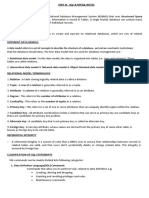0% found this document useful (0 votes)
20 views22 pages12 Cs Study Material On SQL
The document provides an overview of MySQL, a free open-source Relational Database Management System (RDBMS) that utilizes Structured Query Language (SQL) for managing data stored in tables. It discusses the advantages of using a Database Management System (DBMS), relational model terminology, SQL statement classifications, and various SQL commands for database operations. Additionally, it covers data types, integrity constraints, SQL joins, and includes a worksheet for assessment.
Uploaded by
shivanshusri0880Copyright
© © All Rights Reserved
We take content rights seriously. If you suspect this is your content, claim it here.
Available Formats
Download as PDF, TXT or read online on Scribd
0% found this document useful (0 votes)
20 views22 pages12 Cs Study Material On SQL
The document provides an overview of MySQL, a free open-source Relational Database Management System (RDBMS) that utilizes Structured Query Language (SQL) for managing data stored in tables. It discusses the advantages of using a Database Management System (DBMS), relational model terminology, SQL statement classifications, and various SQL commands for database operations. Additionally, it covers data types, integrity constraints, SQL joins, and includes a worksheet for assessment.
Uploaded by
shivanshusri0880Copyright
© © All Rights Reserved
We take content rights seriously. If you suspect this is your content, claim it here.
Available Formats
Download as PDF, TXT or read online on Scribd
/ 22
















































































